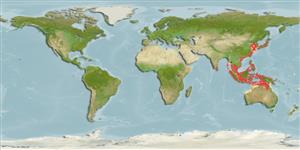Classification / Names
Common names from other countries
Main reference
Size / Weight / Age
Max length : 30.0 cm SL male/unsexed; (Ref. 559)
Environment
Marine; demersal; depth range 20 - 85 m (Ref. 11230)
Climate / Range
Deep-water, preferred ?
Distribution
Indo-West Pacific: South China Sea (Amoy, Canton, Kowloon, Hong Kong and Shanton) through Taiwan, Shanghai, Tunghai and Pohai to Korea and Japan. Known from Shizuoka Prefecture to the South China Sea (Ref. 559). Also found in Indonesia (Ref. 5978).
Countries | FAO areas | Ecosystems | Occurrences | Introductions
Short description
Body comparatively deep (23 to 28% SL). Maxilla extending only to point equal with verticals through middle and posterior margin of fixed eye. Corner of mouth nearer to tip of snout than to branchial opening (Ref 9895).
IUCN Red List Status (Ref. 115185)
Threat to humans
Harmless
Human uses
Fisheries: commercial
More information
ReferencesAquacultureAquaculture profileStrainsGeneticsAllele frequenciesHeritabilityDiseasesProcessingMass conversion
Tools
Special reports
Download XML
Internet sources
Estimates of some properties based on models
Phylogenetic diversity index
PD50 = 0.5000 many relatives (e.g. carps) 0.5 - 2.0 few relatives (e.g. lungfishes)
Trophic Level
3.5 ±0.37 se; Based on food items.
Resilience
Medium, minimum population doubling time 1.4 - 4.4 years (tmax=4-5)
Vulnerability
Moderate to high vulnerability (49 of 100)
Price category
